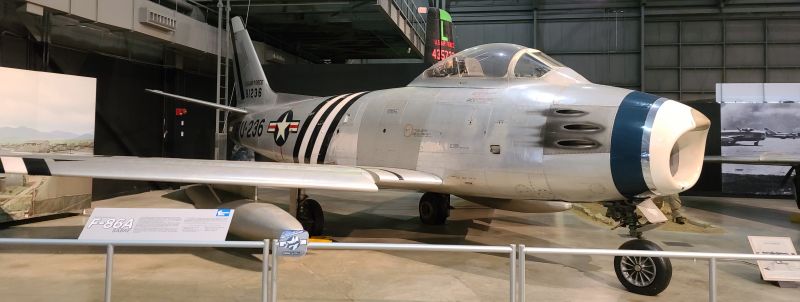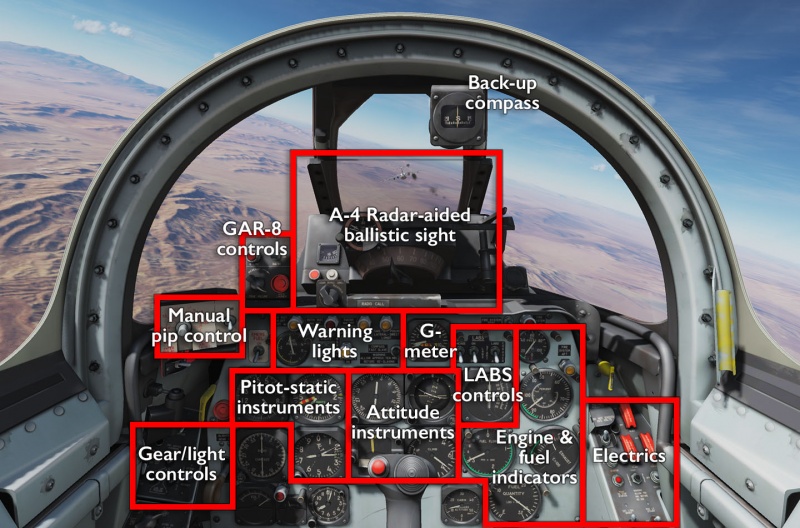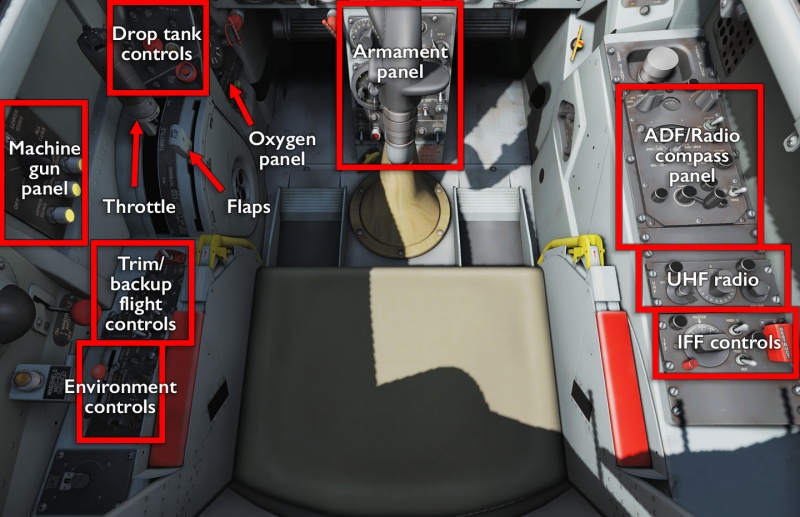F-86F Sabre
| This is a beta module.
This module is still being developed and may still be missing some features and equipment options. It is playable and most of the content is there, but some final touches and fixes for minor bugs are still in the works. It is probably safe to buy unless you crave absolute fidelity and/or very few bugs. |
The F-86F was the most produced variant of the Sabre and made its mark in the skies over Korea as it, opposite the MiG-15, precipitated a new age of air combat — one dominated by the swept-wing jet fighter. The threat of potentially nuclear-equipped B-29 bombers demanded the introduction of the MiG-15 as a transsonic interceptor, which in turn demanded the introduction of the Sabre as a means to defeat those fast-moving interceptors using newfangled contraptions such as on-board radar and self-guided missiles.
In DCS World, the two Korean-war era fighters sit in a curious position, only slightly more advanced than the WWII-era fighters that preceded them, with very few systems to speak of, but with flight characteristics and handling that is much more in line with what we have come to expect from later-generation aircraft. They are no longer torque-heavy tail-draggers, but are not yet loaded with sensors or pilot aids or other automated system. The absolute first fledgling steps of the early jets have been taken, but some teething problems still exist.
Features
The features of the F-86F may seem trivial, but compared to, say the P-51D, or even to the MiG-15, these are significant steps forward:
- A tricycle landing gear with push-button nose-wheel-steering and proper toe brakes.
- Stand-off air-to-air capability with GAR-8 IR missiles (even though they are technically post-Korea).
- Stand-offish A2A and A2G capability with 4× .50" machine guns, guided by the A-4 radar-ranging sight.
- On-board sight adjustment calculator aid for manual bombing..
- Semi-automated low-altitude bombing system (LABS) for very fancy toss-bombing by way of doing loops over the target.
- More rockets than one would think strictly necessary.
- Speed brakes(!)
Missing features
While the F-86F is considered “released” and is not sold as an early-access module, it is still incomplete in one critical area: the manual. The latest version from 2016 still features numerous “to do” notices, missing or incorrect images, and even missing sections. None of them are critical to getting the F-86F into the air and to use it in combat, but it is definitely still a work in progress.
Flying the F-86F
The F-86F was designed to go high and fast, but at this early stage, the kinks in the high-speed jet design were still being worked out. When encountering high compressibility — close to mach speed, and especially at lower altitudes — it loses aileron effectiveness and is prone to unintentional rolling due to the wing design. Similarly, while capable of pulling high G:s and high AoA, doing so can easily result in stalls and spins, both of which require a fair amount of altitude to get out of, and if it picks up excessive speed during that descent, the aileron effectiveness issue kicks in and makes controlled recovery that much harder.
…but other than that, it's a really easy and hands-on aircraft to fly. Just be careful not to yank on the throttle too much, since that will tend to cause compressor issues that can kill the engine, and you once again need a fair bit of altitude to restart it. The temptation to do a lot of yanking is pretty high, though, since it is not the most responsive engine in the world.
Cockpit overview
Getting into the air
As an early post-propeller aircraft, the F-86F had reached the stage were some starting automation became necessary over having to manually balance magnetos and primers and starter motor timings, but where it was still very little that needed to be started besides the engine. The only real complication is that ground power is required to provide run the engine starter. As such, the procedure for getting the Sabre going is mercifully brief:
- Request ground power and turn on alternate controls (using the red switch just aft of the throttle).
- Turn the engine switch on, then move the battery switch to the starter position for a second or two to get the starter started.
- As the engine spools up, first move the throttle from “off” to the “outboard”, position, and then forward to “idle.”
- Make sure the generator is turned on and working.
- …aaand that's about it, really.
With the engine running, hydraulic pressure starts building up, which allows the manipulation of air brakes, flaps, and the normal flight controls. So:
- Disconnect ground power, turn off alternate controls again, set brakes and flaps.
- Close the canopy and turn on oxygen.
- Find a runway and take off, as you do.
Shooting something
Like so many other things in the F-86F, the weapon selection process is rather quick and easy and reminiscent of how things worked in the P-51D, with just a few more modern flourishes:
- On the centre console, move the weapon selector dial to “Sight camera and radar” to spin up the sight gyro and warm up the radar.
- Also on the centre console, move the sight selector dial to “Gun.”
- Cage the mechanical sight using the tiny lever on the right side of the A-4 sight and dial in maximum range on the throttle's rotary handle.
- After 10 minutes, the A-4 sight is warmed up and you can turn the weapons dial to “Guns” (or “Missile”).
(You can do this earlier as well, but you will have to use unaided manual aiming.) - On the left wall gun panel, pick how much gun you want. Top tip: all guns.
- Find a target and figure out what it is.
- Uncage the mechanical sight, and while fiddling in the same place, set the target wingspan (in feet, so 32 for a MiG-15).
- Manoeuvre to the target into your sights — the sight radar target indicator will start to blink if it is picking something up and be steady if something is immediately trackable.
- Press and hold the electric sight cage button on the throttle to command a lock on whatever the sight radar is detecting. The light will go steady and the sight will begin tracking if it succeeds.
- Put the thing on the thing and fire.
Links and files
- Vehicle Size Chart for sight adjustments.
- Chuck's F-86F guide at Mudspike.
- DCS: F-86F Sabre by Belsimtek in the DCS shop.
Related DCS modules
- Hunters over the Yalu Campaign by Reflected Simulations
- The Museum Relic Campaign by Apache600 (works with either one of the F-86F and MiG-15 modules).
More information

- North American F-86 Sabre on wikpedia.
- F-86 “Sabre” on globalsecurity.org
- Bunyap's Test Flight - DCS: F-86F Sabre video series.





